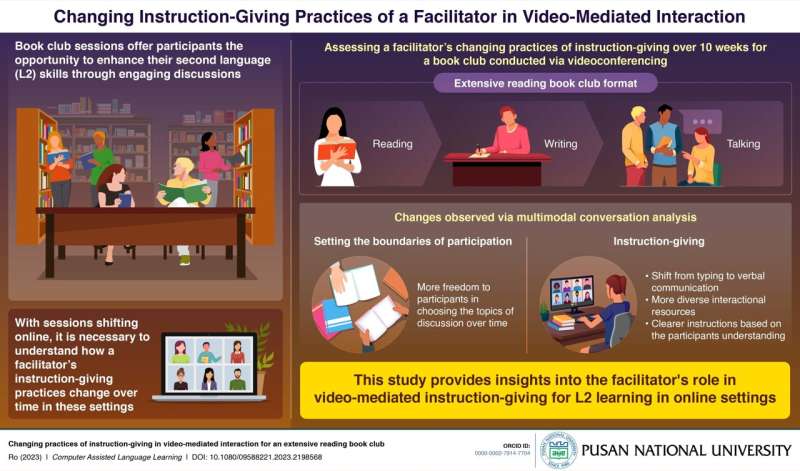This article has been reviewed according to Science X's editorial process and policies. Editors have highlighted the following attributes while ensuring the content's credibility:
fact-checked
proofread
Investigating instruction-giving in video-mediated second language learning

When it comes to learning a language, there is no better opportunity to practice reading, writing, listening, and speaking than a book club. Within its supportive and interactive atmosphere, participants can engage in lively discussions with peers and also receive valuable guidance and feedback on their language usage from a facilitator.
However, as book clubs gradually transition to online platforms and rely more on video interaction sessions, the nature of the interaction between participants and facilitators may change, affecting the overall learning experience.
To examine these changes, Assistant Professor Eunseok Ro from the Department of English Education at Pusan National University in Korea set up an extensive reading book club using Zoom, a popular videoconferencing tool, and closely observed how the facilitator gradually changed her approach to manage the club in this new virtual environment.
"I wanted to analyze how the facilitator established the boundaries of participation and adapted her instruction-giving practices for the book club activity," explains Dr. Ro. His work was published in the journal Computer Assisted Language Learning.
The book club involved five Korean university students aiming to improve their English as a second language. It was conducted once a week for 10 weeks and was led by an English teacher based in the United States.
While it was the facilitator's first time teaching through video-mediated interaction, she had the freedom to design her own instructional procedures and establish boundaries of discussion for the book club activity. In addition, participants were allowed to select books for themselves and were encouraged to read them as much as possible before attending the online meeting.
In the meetings, the participants silently read their chosen books, prepared for their upcoming book talk by writing down the things to speak, and then spent time talking about their book in turns and asking each other questions. In this setup, Dr. Ro observed and analyzed the change in the facilitator's instruction-giving practices over time through a multimodal conversation analysis approach.
Initially, the facilitator regularly guided the participants to provide structure to the activity and facilitate discussions. Each week, she provided them with a list of prompt questions, which not only set the boundaries and focus of the discussion but also served as cues, giving participants specific topics to explore. As the book club progressed, however, she moved away from providing specific questions and allowed participants more freedom to choose their own topics for discussion.
Further, while the facilitator initially gave instructions by typing them into the chat box, she started delivering the questions orally by the third week. From the seventh week onward, she started discussing the prompt questions orally alongside copying and pasting them in a chat box. She also employed more diverse interactional resources and tailored the questions to match each participant's level of understanding.
"These observations add to the growing body of research on language teaching and specifically on facilitators' roles in video-mediated interactions," says Dr. Ro. This study's methodological approach could also influence future research in video-mediated interaction, possibly leading to improved analysis techniques.
Furthermore, with the growing trend of incorporating digital technologies to enhance teaching, examining the changes in instruction-giving practices can guide educators and help them effectively deliver instructions during video-mediated interactions, ensuring a successful learning experience for students.
More information: Eunseok Ro, Changing practices of instruction-giving in video-mediated interaction for an extensive reading book club, Computer Assisted Language Learning (2023). DOI: 10.1080/09588221.2023.2198568
Provided by Pusan National University





















